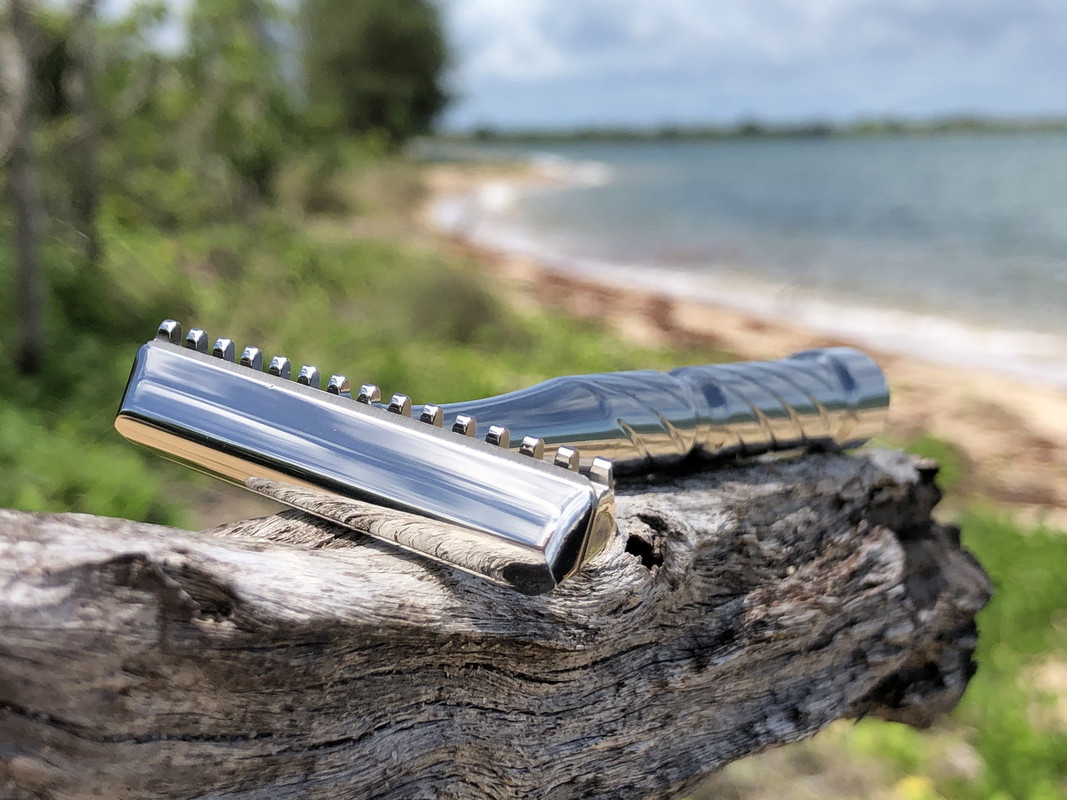Blackland Vector OC Polished – (USA)

Blacklands Vector SE razors have been released for something like three years but how often do you seen one for sale on a BST? Rarely, and there is a good reason; they are a very good razor with a well deserved reputation as a great user friendly SE razor. I used the Vector not long after it was first released in 2018 and came away very impressed. I have now acquired a second Vector with both SB and OC plates in a polished finish, this week I’ll be using the OC plate. Artist Club blades have three, long, narrow, elongated holes running along the centre that are way too narrow for a typical 5mm dia handle post to fit through. If only the head could be made to similar dimensions of a SE blade; with their thinking cap on, Blackland simply machined both sides off the 5mm handle post till it slipped through the AC blade. Now, machine all the excess material from around the cap and plate, and what you’re left with is a Blackland Vector, only marginally larger that the dimensions of an AC blade. On this scaled down head, anything but the finest comb teeth would look out of place, another tick for Blackland. There were those of us who questioned the longevity of the machined handle post but I’ve not heard of one instance where the handle has cross threaded or broken, don’t talk too loud Errol. In keeping with the minimalist design of the head, Vector’s handle is long and thin but from previous experience this handle performs admirably and above all, suits this application.
When the only criticism I have of a razor is that I have to rinse more often than usual, it’s a pretty good piece of kit. Efficiency wise, the Vector OC equates to around that of a Karve CB level #D, there is a pleasant amount of blade feel and those fine teeth do little more than tickle as they glide over the face. What really surprises is just how well that long, narrow handle performs. I usually don’t appreciate long handles in the first place and then when the handle is machined down till there’s very little left? Well! it works, and it works well. When I reviewed the machined version I remember having difficulty seeing the blade against the cap, the two parts blended together. I even suggested to Shane at the time that a jet black option would be my choice, but now using with the polished version I did not experience as much of a problem. This Vector razor continues to deliver a close and smooth shaving experience that its users appreciate. Delightful.
Blades Used – Schick P-30 and Kia Captain Titan Mild Pink
Material – 303 Stainless steel
Blade Tab - Covered
Weight – 76g
Head Width – 50.08mm
Handle Length – 91.97mm
Handle Diameter – 10.94mm
Availability – Blackland
Final Word – Good stuff

Blacklands Vector SE razors have been released for something like three years but how often do you seen one for sale on a BST? Rarely, and there is a good reason; they are a very good razor with a well deserved reputation as a great user friendly SE razor. I used the Vector not long after it was first released in 2018 and came away very impressed. I have now acquired a second Vector with both SB and OC plates in a polished finish, this week I’ll be using the OC plate. Artist Club blades have three, long, narrow, elongated holes running along the centre that are way too narrow for a typical 5mm dia handle post to fit through. If only the head could be made to similar dimensions of a SE blade; with their thinking cap on, Blackland simply machined both sides off the 5mm handle post till it slipped through the AC blade. Now, machine all the excess material from around the cap and plate, and what you’re left with is a Blackland Vector, only marginally larger that the dimensions of an AC blade. On this scaled down head, anything but the finest comb teeth would look out of place, another tick for Blackland. There were those of us who questioned the longevity of the machined handle post but I’ve not heard of one instance where the handle has cross threaded or broken, don’t talk too loud Errol. In keeping with the minimalist design of the head, Vector’s handle is long and thin but from previous experience this handle performs admirably and above all, suits this application.
When the only criticism I have of a razor is that I have to rinse more often than usual, it’s a pretty good piece of kit. Efficiency wise, the Vector OC equates to around that of a Karve CB level #D, there is a pleasant amount of blade feel and those fine teeth do little more than tickle as they glide over the face. What really surprises is just how well that long, narrow handle performs. I usually don’t appreciate long handles in the first place and then when the handle is machined down till there’s very little left? Well! it works, and it works well. When I reviewed the machined version I remember having difficulty seeing the blade against the cap, the two parts blended together. I even suggested to Shane at the time that a jet black option would be my choice, but now using with the polished version I did not experience as much of a problem. This Vector razor continues to deliver a close and smooth shaving experience that its users appreciate. Delightful.
Blades Used – Schick P-30 and Kia Captain Titan Mild Pink
Material – 303 Stainless steel
Blade Tab - Covered
Weight – 76g
Head Width – 50.08mm
Handle Length – 91.97mm
Handle Diameter – 10.94mm
Availability – Blackland
Final Word – Good stuff


